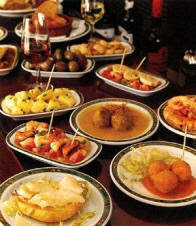 "Tapas" is the name of a wide variety of appetizers, or snacks. They may be cold (such as mixed olives and cheese) or warm. Tapas have evolved to become a key part of sophisticated cuisine, as more restaurants add tapas to their menu and people start experimenting in their home with a variety of items including delicious dips like Summer Fresh Original Hummus or Summer Fresh Tzatziki.
"Tapas" is the name of a wide variety of appetizers, or snacks. They may be cold (such as mixed olives and cheese) or warm. Tapas have evolved to become a key part of sophisticated cuisine, as more restaurants add tapas to their menu and people start experimenting in their home with a variety of items including delicious dips like Summer Fresh Original Hummus or Summer Fresh Tzatziki.
DÉCOR - Hosting your party outside is the perfect venue to compliment the food being served.
• To create an authentic experience, purchase a low table (similar to ones at authentic Japanese restaurants) and place large, over stuffed pillows in bold colours like pink, orange and teal on the ground around it. This will be the seating area.
• Place glass vases on the table to hold bamboo skewers and toothpicks to pick up food.
• Place an empty shot glass, or empty votive candle holder at each place setting for empty toothpicks.
• Set out pitchers of water, or sparkling water, along with white and red wine on ice.
• For a centerpiece place a line of pink or orange tea light holders down the middle of the tables and light the candles.
• If you want a bold centerpiece, fill a large vase with fresh, cut sunflowers.
FOOD EXPERIENCE – Create a decadent array of finger foods inspired by Spain!
• Set out dishes of olives, pita bread, oil and Summer Fresh Roasted Red Pepper Hummus.
• Fill a shot glass with Summer Fresh Seven Grain Salad for individual servings.
• Create “Patatas Bravas” by slicing russet potatoes into circles, brushing with Summer Fresh Spicy Artichoke & Asiago Dip and pan frying them. Serve HOT.
• Drizzle Summer Fresh Provolone & Onion Hot Cheesy Dip over grilled shrimp and skewer with grilled mushrooms.
• Spread Summer Fresh Spicy Hummus onto one side of a sliced baguette; add grilled chicken and Summer Fresh Taboulah Salad. Top with additional slice and cut into small pieces.
• Grill naan bread and cut into wedges. Serve with Summer Fresh Baba Ghanouj.
• Stuff button mushroom caps with Summer Fresh Greek Couscous Salad and serve with a tablespoon of Summer Fresh Roasted Garlic Hummus.
• Slice a cucumber in half lengthwise and scoop out a trough down the middle. Mix together Summer Fresh Bruschetta and feta cheese and fill the trough. Slice into 2" lengths and serve.
• Spread Summer Fresh Sundried Tomato & Kalamata Olive Feta Spread on to a slice of prosciutto and roll over a spear of asparagus.
• Pour Summer Fresh Sundried Tomato & Parmesan Dip over cooked meatballs, pierce with a toothpick and serve.
• For dessert, spoon Summer Fresh Maple Walnut Topping into chocolate shells.
• Spread Summer Fresh Cranberry Pomegranate Topping over a brick of cream cheese and heat for 10 seconds. Serve with Graham crackers.
APRÉS DINNER – As dinner winds down, sit back under the stars and relax!
• Provide guests with a variety of beverages including red & white wine, sangria, coffee and water.
• Put on some Spanish music and encourage your guests to get up and dance!
• As a party favour, create recipe cards for the tapas foods your guests have enjoyed.
 Plain steamed rice is an essential item for Japanese-style breakfast. Okayu (rice porridge) is easy to digest and is good for breakfast too. Okayu is easy to digest and is easy to eat. When you have a stomachache or have a cold, okayu is a good food to eat.
Plain steamed rice is an essential item for Japanese-style breakfast. Okayu (rice porridge) is easy to digest and is good for breakfast too. Okayu is easy to digest and is easy to eat. When you have a stomachache or have a cold, okayu is a good food to eat.









